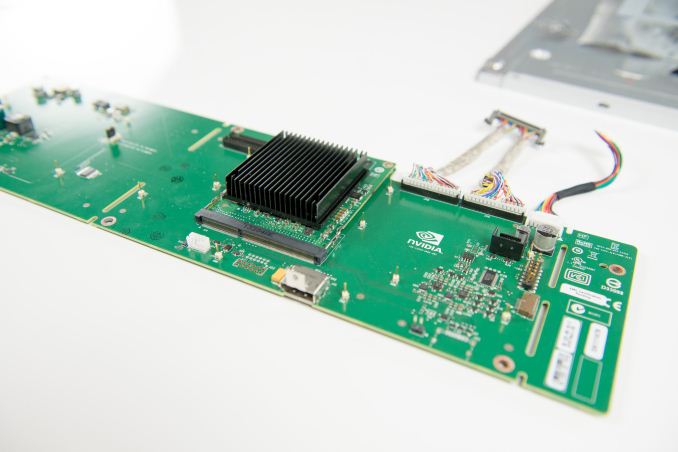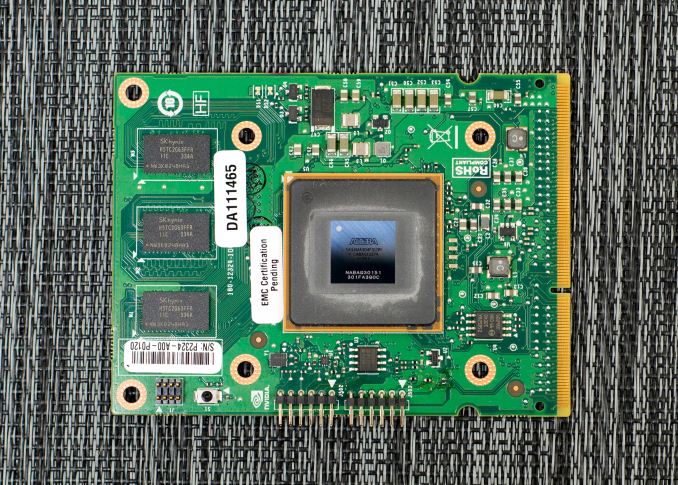NVIDIA G-Sync Review
by Anand Lal Shimpi on December 12, 2013 9:00 AM ESTFinal Words
After spending a few days with G-Sync, I’m just as convinced as I was in Montreal. The technology, albeit a relatively simple manipulation of display timing, is a key ingredient in delivering a substantially better gaming experience.
In pathological cases the impact can be shocking, particularly if you’re coming from a 60Hz panel today (with or without v-sync). The smoothness afforded by G-Sync is just awesome. I didn’t even realize how much of the v-sync related stutter I had simply come to accept. I’d frequently find a scene that stuttered a lot with v-sync enabled and approach it fully expecting G-Sync to somehow fail at smoothing things out this time. I always came away impressed. G-Sync also lowered my minimum frame rate requirement to not be distracted by stuttering. Dropping below 30 fps is still bothersome, but in all of the games I tested as long as I could keep frame rates north of 35 fps the overall experience was great.
In many situations the impact of G-Sync can be subtle. If you’re not overly bothered by tearing or are ok with v-sync stuttering, there’s really nothing G-Sync can offer you. There’s also the fact that G-Sync optimizes for a situation that may or may not be so visible 100% of the time. Unlike moving to a higher resolution or increasing quality settings, G-Sync’s value is best realized in specific scenarios where there’s a lot of frame rate variability - particularly between 30 and 60 fps. Staying in that sweet spot is tougher to do on a 1080p panel, especially if you’ve already invested in a pretty fast video card.
If you’re already running games at a fairly constant 60 fps, what G-Sync will allow you to do is to crank up quality levels even more without significantly reducing the smoothness of your experience. I feel like G-Sync will be of even more importance with higher resolution displays where it’s a lot harder to maintain 60 fps. Ideally I’d love to see a 2560 x 1440 G-Sync display with an IPS panel that maybe even ships properly calibrated from the factory. I suspect we’ll at least get the former.
There's also what happens if game developers can assume the world is running on displays with variable refresh rates. All of the sudden targeting frame rates between 30 and 60 fps becomes far less of a tradeoff.
NVIDIA hasn’t disclosed much about G-Sync pricing, although ASUS has already given us a little guidance. The VG248QE currently sells for $280 on Newegg, while the upcoming G-Sync enabled flavor will apparently be sold for $400. The $120 premium can be a tough pill to swallow. A 40% increase in display cost is steep, which is another reason why I feel like NVIDIA might have a little more success pushing G-Sync as a part of a higher end display. On the flip side NVIDIA could easily get those costs down by migrating from an FPGA to an ASIC, although to justify that move we’d have to see pretty broad adoption of G-Sync.
Some system integrators will be selling the aftermarket upgraded VG248QE between now and CES, but you can expect other displays to be announced over the coming months. NVIDIA still hasn't figured out if/how it wants to handle end user upgrades for those who already own VG248QE displays.
I feel like NVIDIA is slowly but surely assembling a bunch of components of a truly next-generation gaming experience. With all of the new consoles launched, the bar is set for the next several years. PCs already exceed what consoles are capable of in terms of performance, but the focus going forward really needs to be on improving ease of use as well as the rest of the experience. Things like GeForce Experience are a step in the right direction, but they need far more polish and honestly, integration into something like Steam. G-Sync just adds to the list. For PC gaming to continue to thrive, it needs to evolve into something even more polished than it is today. It’s not enough to just offer higher resolution and a better looking image than what you can get on other platforms, it’s very important to provide a smoother and more consistent experience as well. G-Sync attempts to and succeeds at doing just that.
With G-Sync enabled, I began to expect/demand more visually from my games. Aliasing and other rendering imperfections were far more pronounced now that a big portion of stuttering was removed. G-Sync isn't the final solution, but rather the first on a long list of things that need improving. There are other use cases for G-Sync outside of gaming as well. Streaming video where bandwidth constraints force a variable frame rate is another one I’ve heard passed around.
Although G-Sync is limited to NVIDIA hardware (GeForce GTX 650 Ti Boost or greater), the implementation seems simple enough that other manufacturers should be able to do something similar. That’s obviously the biggest issue with what we have here today - it only works with NVIDIA hardware. For die hard NVIDIA fans, I can absolutely see a G-Sync monitor as being a worthy investment. You might just want to wait for some more displays to hit the market first.












193 Comments
View All Comments
spejr - Sunday, December 15, 2013 - link
This seems to be perfect for mobile gaming. Only one unit, and constant lack of performance. And i dont think the cost of implementation has to be 120, thats such a random figure taken out of context.spejr - Sunday, December 15, 2013 - link
And also i dont get the argument "but with lots of power you dont need it blablablah...". It's one thing that is even better, enabling even better performance in even more demanding situationsrms - Monday, December 16, 2013 - link
I'd love to see a report on how this behaves with a title like Deus Ex:HR-DC, which has an egregious stuttering issue in hub areas. It's not clear this stuttering is a rendering issue, so how would g-sync respond?Farfle - Monday, December 16, 2013 - link
No mention of mouse lag in the article. Somehow, it goes unnoticed by some folks, while for others ( me) it downright makes the game unplayable, at least competitively.With V-Sync on and the system capped at 60fps, mouse lag on some games is just terrible. Forget stuttering and scream tearing, for me this is much worse. That's why I bought a 120hz LCD. I can either turn VSync off and enjoy zero mouse lag and relatively no tearing on modern games that are FPS-bound; or I can turn VSync on and experience considerably less lag than at 60hz and a beautiful artifact-free picture.
But if Gsync eliminates mouse lag entirely, as well as any visual issues, that seems like an awesome tech that I wish were implemented in all setups. Although it wouldn't be as useful for someone with a 120hz+ display as 60hz, it'd still be a better overall experience
beck2050 - Wednesday, December 18, 2013 - link
Awesome tech. I saw a demo of it and it is silky. I want a 780 ti ACX to go with it and should be good for a while.nadroj1485 - Wednesday, December 18, 2013 - link
I wonder what the prices will be like once this goins mainstream.cedarson - Friday, December 20, 2013 - link
I am so saving up for a 27+ inch version of this.mlmcasual - Monday, December 23, 2013 - link
One of the BIGGEST FAILS at introducing a new. Tech I have ever witnessed.1080P=Automatic fail. As the author mentioned, the entire point of the technology would be suited for a higher res. Investing 400$ for a 1080P? No thanks. This is a complete mismatching of technology. If you can't run over 60fps on a 1080p monitor, you don't need to spend 400$ on a proprietary monitor that can look good at 30hz.. you would start with a better vid. card.
somatzu - Friday, January 10, 2014 - link
Hi, everyone. I have a gtx 670 paired with an ASUS VG248qe. I've always thought that I've been quite sensitive to screen tearing, and once I started playing games with vsync off at 120/144hz refresh rates, tearing seemed to have disappeared altogether. Whether it's bioshock or spelunky, the buttery smooth motion flits past my monitor with no tearing. Of course, when I can't match my output FPS to the high refresh rate of my monitor, there's some motion blur (with LB on or off), but no tearing.So, it seems like g-sync is unnecessary for me because my gfx card doesn't need to throttle itself to match my monitor's high refresh rate. I probably won't see any difference, in fact, as the article stated, I'll see a slight decrease in fps. Anand was using a 760, which seems like a better fit for g-sync. But would someone with a gtx670 and a high refresh rate monitor (120hz<) really need this technology?
NavasC - Thursday, January 16, 2014 - link
Somatzu - I just recently completed a DIY on this myself and I have a GTX Titan. There are still some pretty demanding games like Metro: Last Light and BF4 multiplayer that occasionally bring frame dips down to the 40-60 fps range. For those who have higher end PCs, the G-SYNC completely removes the occasional stutter that comes from big frame drops during high-intensity games. And for those games where you tend to hold back on extra features like AntiAliasing, you can now crank them up a little bit and still get really smooth performance. Is it 100% necessary if you've already got a high end rig? Not necessarily, but it's definitely more pleasing to the eye when playing games where frame drops are common (i.e. BF4 multiplayer) and stuttering when you need to twitch is the difference between life and death.Also, the GSYNC module comes equipped with a toggle-able improved "Lightboost" mode called ULMB, so no more ToastyX hack is required for Lightboost.